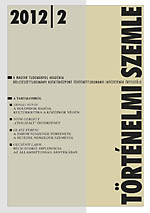„Civilizált” õstörténet. A magyar nyelv és a magyar nemzet eredetének kutatása Bél Mátyás életmûvében
“Civilised” Prehistory. Research of the Origins of the Hungarian Language and Nation in the Oeuvre of Mátyás Bél
Author(s): Gergely TóthSubject(s): History
Published by: Magyar Tudományos Akadémia Bölcsészettudományi Kutatóközpont Történettudományi Intézet
Summary/Abstract: Mátyás Bél (1684–1749), the famous historian from Hungary, paid a good deal of attention throughout his life to the genesis of the Hungarian language and alphabet, as well as to the origins of the Hungarian nation itself. As for the roots of the Hungarian language, Bél’s most important means of inquiry was Hebrew comparison on a Biblical basis (that is, comparing the individual languages to Hebrew), a method which had long been dominant in Europe but was already on the wane in the time of Bél. In support of it he elaborated a particular theory of his own. According to it Japheth, the ancestor of the Scythians and (in his interpretation) of the Hungarians, did not take part in the construction of the tower of Babel, and consequently his descendants preserved the “Adamic language”, that is, Hebrew, which would account for the “relationship” between Hebrew and Hungarian. The aim of Bél was to find a, possibly illustrious, place for the Hungarian language, generally unknown and thus regarded as barbarous, on the great linguistic tree, and to determine its position with regard to Hebrew and other languages. The same aim was served by the supposed relationship between the Székely (Szekler) runic writing and the ancient eastern alphabets, before all Hebrew; the Hungarians, and their supposed ancestors, the Huns and the Scythians, could thus be presented as nations of a very ancient culture. As for the origins of the nation, Bél stuck to his opinion throughout his life, proclaiming as he did that the Hungarians were of a Hun–Scythian–Avar origin. His stubbornness should presumably be accounted for by the fact that the new theories arguing for the Finno–Hungarian linguistic and ethnic relationship (Leibniz, Bayer) were then still far from solidly established. Consequently, Bél continued to adhere to the old theory, but wished to present it in a new form. Making use of the ancient and medieval narrative works, he intended to breathe new life into the concept of Scythian–Hun–Avar–Hungarian identity, and thereby to offer a critical prehistory of scientific character, by elaborating similarities in lifestyle between the Hungarians and their Scythian and Hun predecessors. The model he followed was probably Clüver’s Germania antiqua. By attenuating the descriptions of Ammianus, and emphasizing the neutral or positive remarks by Priscus, he tried to neutralise the negative overtones of Scythian, and especially of Hun origins, for the negative image of the Huns was utterly detrimental to the contemporary view of the Hungarians. Bél, of Slovak origins, attributed a role to the “Slavs” (Slovaks) as well in his prehistorical conception: he identified them as the Sarmatians and accordingly regarded them as indigeneous. However, he argued that the Slavs had entered into an alliance, and even merged, with both the Huns and the Hungarians, a reflection of the concept of the “host nation” which characterised contemporary Slovak thinking.
Journal: Történelmi Szemle
- Issue Year: 2012
- Issue No: 02
- Page Range: 219-246
- Page Count: 28
- Language: Hungarian

